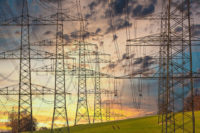Hurricane Ida dealt a “catastrophic” blow to the electric grid in New Orleans and southeast Louisiana as it moved through the state Aug. 29. All eight of the transmission lines to the city failed, leaving it completely in the dark.
Power company Entergy said the hurricane winds and rain toppled transmission, power poles and other equipment, causing outages for approximately 895,000 Entergy New Orleans and Entergy Louisiana customers as of 11 a.m. Aug. 30.
Additional utilities reported more than 110,000 customers without power, resulting in a total of 47% of the state’s customers without power. About 100,000 customers were without power in Mississippi, according to utility reports.
“Electricity is practically non-existent for most people in Southeast Louisiana,” said Louisiana Gov. John Bel Edwards (D) Aug. 30.
[Read more about Hurricane Ida's impacts throughout Louisiana here]
Entergy New Orleans says it will take up to four days to asses the damage to the transmission lines, according to local TV station WWL. It will simultaneously begin repairs while other teams begin to assess and repair distribution lines, said Deanna Rodriguez, its president and CEO during a press briefing Aug. 30. She said it wasn’t yet known how severe the damage to the transmission lines is. Some could be minimal.
One of the major lines failed when a a tall tower on the west bank of the Mississippi River, which faces New Orleans, crumpled to the ground during the storm, leaving the transmission lines in the river. That tower withstood Hurricane Katrina in 2005, Entergy said.
Rodriguez says a total of 2,000 miles of transmission lines are out of service. Entergy says 216 substations are out of service. Up to 25,000 line workers were already in the state, and several thousand more were on the way, Edwards said Aug. 30. He said there were more workers committed to the restoration efforts “than we’ve ever seen.”
An industry expert in transmission told ENR that at least three transmission lines into the city will have to be restored to bring power back, and that’s if industry in the area doesn’t immediately need power.
New Orleans is essentially a peninsula, surrounded by water. The sole power plant within city limits is not in operation. Other power has to cross the river by overhead or underwater lines.
Entergy said, based on historic restoration times, that 90% of those without power will likely be restored within three weeks. But other restorations could take longer.
“This will be a marathon, not a sprint,” Rodriguez said. “We’re working as safely and quickly as we can, but recovery will vary depending on the damage incurred and its location. We must all be prepared for the recovery to take some time.”
Outside of New Orleans, in areas hard to reach because of flooding or storm damage, Entergy is using infrared cameras, drones and satellite imagery.
The power outage caused a cascade of problems for the area. New Orleans uses powered pumps to drain the below-sea-level city when it rains.
After the transmission failure, Entergy supplied generators to keep those pumps working and flooding in the city was minimal. But there still is no power to the wastewater pumps, and the city is urging residents to use as little water as possible to prevent sewer backups.





Post a comment to this article
Report Abusive Comment